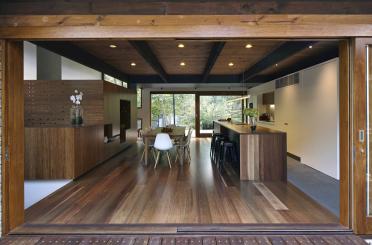Timber flooring can be a beautiful, enduring asset for homes, workplaces, sporting venues and other locations. It is essential however, that they are correctly installed and maintained. In this 7 module course you will learn about the properties of various types of timber (and bamboo) flooring and how each should be installed. You will also learn about the importance of preparation before installation and how features of the site can affect the flooring.
This is a stand-alone online course that includes video lectures and tutorial questions to test your knowledge.
The course comprises 7 Modules
Module 1 Allowing for floor expansion and shrinkage
This topic examines the properties and effects of floor movement. Floors move because timber expands and contracts, in response to seasonal variations in humidity and temperature.
Three areas of movement are covered in this module:
- Shrinkage and swelling due to changes in moisture content
- Why expansion allowance is a must, not an option
- Expansion allowance in fixed and floated floors
Module 2 Importance of assessing subfloors
This module discusses the importance of assessing a subfloor in maintaining the integrity of the whole floor.
The subfloor is beneath a floor, and unless it is laid correctly, the floor won’t perform to its optimum structural ability and will have a reduced service life.
There are many different types of subfloor that timber floors can be laid over, and therefore different aspects that need to be assessed.
You'll learn about three areas:
- Why it is important to assess subfloors
- Assessing timber subfloors
- Assessing concrete subfloors
Module 3 Assessing timber and concrete moisture
Timber and concrete moisture assessment is an essential part of laying most timber floors. In this module, we’ll assess the necessities of concrete and timber moisture assessment. It’s been found that many people who should have a moisture meter, do not and that many who do, use them incorrectly.
The three important elements of moisture assessment we’ll discuss are:
- Why moisture assessment is important
- Assessing timber moisture
- Assessing concrete moisture
Module 4 Acclimatisation
In this module, we will discuss acclimatisation of timber flooring. It’s a term that most, whether builder, architect or owner, have heard of, but few understand. There are certain misconceptions about the necessity and appropriate use of acclimatisation in timber flooring, which has led to some incorrect practices.
Here we will consider the details of acclimatising solid strip timber flooring, including:
- Why it is done
- What needs to be considered
- How it is done
We will also briefly touch on how the term relates to alternative timber floor products such as engineered flooring, bamboo, and laminate.
Module 5 Laying timber floors over concrete slabs
This module covers laying a solid strip timber floor over a concrete slab. It’s common for Australian houses and apartments to have timber floors laid on concrete as their flooring system.
You’ll learn the best practice for laying these floors, including;
Solid timber flooring that is:
- Site sanded and coated strip floors
- Pre-finished solid strip floor
- Parquetry
Engineered, bamboo and laminate flooring that is:
- Adhesive fixed (not laminate)
- Floated flooring systems
Module 6 Installation over acoustic underlays
High rise residences are becoming increasingly common in our cities and suburbs. In this module we look at minimising noise transfer between apartments in multi-res buildings. Before we consider installation solutions, it’s important to understand ‘noise’ and the requirements for acoustic treatment.
We’ll be covering:
- Noise measurement
- National Construction Code, strata title and council requirements
- Noise control and testing
- Acoustic underlays
- Installation
Module 7 Coating choices
This module covers coatings for timber floors. We’ll discuss the benefits of understanding different coatings and their properties. We’ll then mention some other finishing options.

